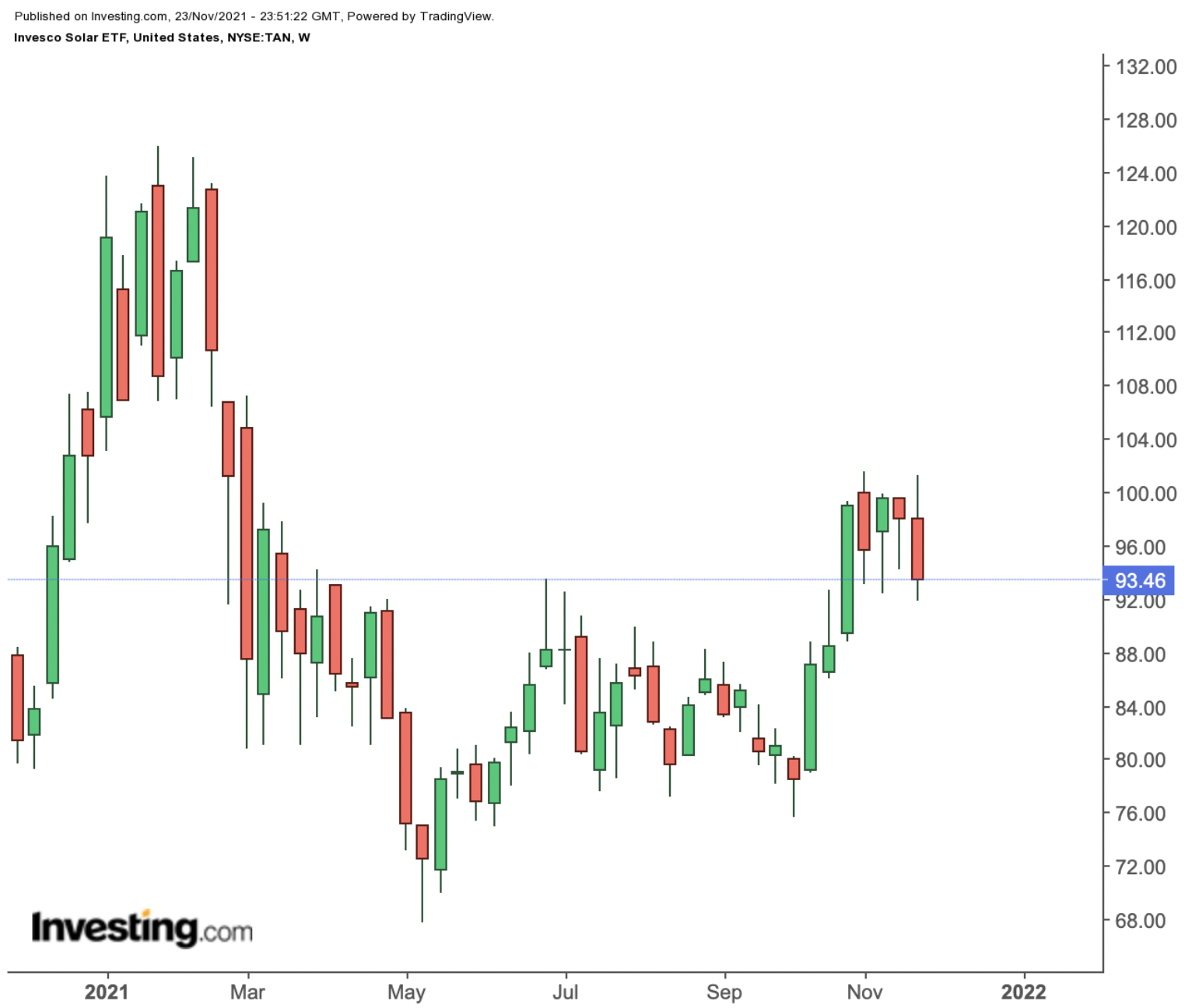Tyson Foods to close major Nebraska beef plant amid cattle shortage - WSJ
So far, 2021 has brought record highs to the three most-followed US indices—the Dow Jones, the S&P 500 and the NASDAQ Composite. They are up more than 21%, 24% and 26%, respectively.
However, not all sectors have seen positive returns this year. So, today we introduce two exchange-traded funds (ETFs) that have declined during the year and could possibly fare better in the weeks ahead.
1. Invesco Solar ETF
- Current Price: $93.46
- 52-Week Range: $67.69 - $125.98
- Dividend Yield: 0.11%
- Expense Ratio: 0.69% per year
The 26th UN Climate Change Conference (COP26), which recently took place in Scotland, put the transition to alternative energy sources in the spotlight. Recent metrics highlight that the global solar energy market could grow from around $170 billion in 2020 to $293 billion in 2028, implying a compound annual growth rate (CAGR) of about 8%.
The Invesco Solar ETF (NYSE:TAN) invests in businesses at the forefront of the solar energy space. The fund was first listed in April 2008.

TAN, which tracks the returns of the MAC Global Solar Energy Index, currently has 53 holdings. Both the index and the fund are rebalanced quarterly.
More than half of the stocks come from the US. Next in line are businesses from China (17.11%), Spain (5.98%), Israel (3.44%), Taiwan (3.39%) and Germany (3.36%). The top 10 companies comprise about 61% of net assets of $3.88 billion. In terms of sectors, we see information technology (58.25%) followed by utilities (20.82%) and industrials (16.25%).
Energy technology group Enphase Energy (NASDAQ:ENPH), which offers software-driven home energy solutions; SolarEdge Technologies (NASDAQ:SEDG), which provides inverter systems for solar photovoltaic installations, Sunrun (NASDAQ:RUN), which focuses on residential solar energy and battery systems, First Solar (NASDAQ:FSLR), which manufactures PV solar modules, and China-based leading solar glass manufacturer Xinyi Solar Holdings (HK:0968) are among the most important names in the fund.
TAN is down more than 7% this year, but still returned about 22.5% in the past 12 months. After seeing a multi-year high in late January, shares comprising the ETF have come under pressure.
The fund’s forward Price/Earnings (P/E) and Price/Book (P/B) ratios stand at 33.53x and 3.27x, respectively. Interested readers could wait for a potential decline toward the $93 level.
2. Global X Social Media ETF
- Current Price: $58.38
- 52-Week Range: $55.33 - $79.00
- Expense Ratio: 0.65% per year
Social media, which is based on digital interactive technologies, has seen significant growth in the past decade, and has become a critical communication tool for individuals, companies and even governments. Meanwhile, ad spending on social media has also been on the rise. In 2021, it is expected to reach almost $154 billion, and well over a third of that amount will be in the US.
According to IBISWorld:
“The market size, measured by revenue, of the social networking sites industry is $62.5 billion in 2021.”
The Global X Social Media ETF (NASDAQ:SOCL) gives exposure to global social media companies. Since its inception in November 2011, net assets have reached $379.6 million.

SOCL, which has 43 holdings, tracks the Solactive Social Media Total Return Index. In terms of sector allocations, communication services have the largest slice, with 92.8%, followed by IT (6%), and consumer discretionary shares (1.2%).
As far as the country breakdown is concerned, the US leads, with more than 44%. Then, we see China (29%), South Korea (10.2%), Luxembourg (5.7%) and the Netherlands (5.3%). The top 10 holdings make up slightly more than 64% of total net assets.
Meta Platforms (NASDAQ:FB), formerly known as Facebook, and China-based Tencent Holdings (HK:0700) (OTC:TCEHY), which is one of the largest social media groups worldwide, have the highest weightings, with 10.80% and 10.37%, respectively.
Next on the roster are the camera and social media stock Snap (NYSE:SNAP), Chinese gaming, e-commerce and advertising group NetEase (NASDAQ:NTES), and the Netherlands-headquartered Internet and technology company Yandex (NASDAQ:YNDX), which was originally founded in Russia.
Year-to-date, the fund is down more than 4.5% but has returned close to 5.5% in the past 52 weeks. SOCL’s trailing P/E and P/B ratios stand at 32.35x and 3.82x, respectively. Readers looking for a pure play exposure to the future of the global social media sector might want to keep SOCL on their radar with a view to invest at around $57.
